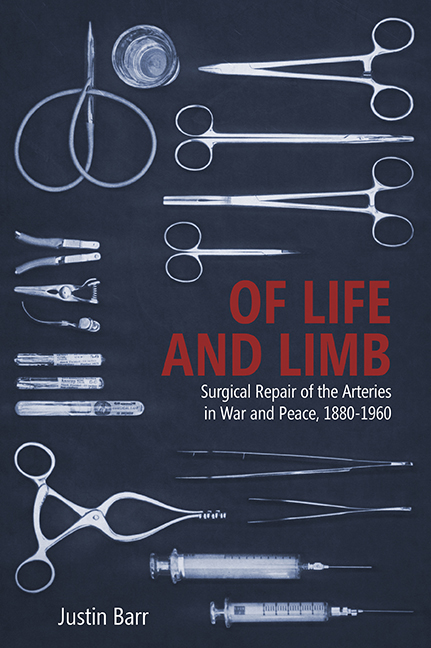 Surgical Repair of the Arteries in War and Peace, 1880–1960
Surgical Repair of the Arteries in War and Peace, 1880–1960 Published online by Cambridge University Press: 29 March 2020
In World War II, only 1 percent of all wounds among American soldiers directly afflicted the vascular system, but these injuries caused a disproportionate 20 percent of amputations. Given these severe consequences, trauma to major arteries attracted extensive medical attention before, during, and after the conflict. Even more than the First World War, the Second World War offered surgeons opportunities to repair vessels and not just ligate them, providing them the chance to preserve arms and legs. Better-trained surgeons worked in conditions markedly improved from the trenches of World War I while retaining extraordinary autonomy of practice and freedom from regulatory oversight. Major battles continued to create thousands of bleeding patients in desperate need of vascular surgery. Medical advances like heparin, arteriograms, and sulfa antibiotics in the interbellum years as well as penicillin and blood transfusion early in the war promised greater success and started to alter both physician and patient expectations: whereas before saving lives was the priority, the conditions of the Second World War made it possible for doctors to focus on life and limb.
Despite these developments, the American military medical leadership entered World War II strongly recommending ligation and sympathectomy for vascular trauma. They believed the speed, simplicity, and effectiveness of this combination therapy superseded any potential benefits of anastomosis. Once again, high rates of amputation proved this prescription wrong. By the end of the war, the prodigious loss of limbs prompted a previously undescribed shift from ligating to repairing arterial injuries on both the front lines and in army hospitals in the United States. Surgeons who had transformed their practice saved the arms and legs of hundreds of Americans, foreshadowing future care. However, when leaders in American surgery wrote several seminal articles downplaying the transition to repairing arteries and its role in military medicine, the therapy faded from use. Only after hundreds of additional amputations during the Korean War did doctors return to arterial repair as the preferred practice, poignantly demonstrating the power of memory and history in shaping the care of patients.
Creating Opportunities for Arterial Repair: Military Medicine in World War II
Military medicine in World War II built on the experiences of the Great War as well as developments in the interwar period to minister to the millions of soldiers, sailors, airmen, marines, and civilians affected by the conflict.
To save this book to your Kindle, first ensure no-reply@cambridge.org is added to your Approved Personal Document E-mail List under your Personal Document Settings on the Manage Your Content and Devices page of your Amazon account. Then enter the ‘name’ part of your Kindle email address below. Find out more about saving to your Kindle.
Note you can select to save to either the @free.kindle.com or @kindle.com variations. ‘@free.kindle.com’ emails are free but can only be saved to your device when it is connected to wi-fi. ‘@kindle.com’ emails can be delivered even when you are not connected to wi-fi, but note that service fees apply.
Find out more about the Kindle Personal Document Service.
To save content items to your account, please confirm that you agree to abide by our usage policies. If this is the first time you use this feature, you will be asked to authorise Cambridge Core to connect with your account. Find out more about saving content to Dropbox.
To save content items to your account, please confirm that you agree to abide by our usage policies. If this is the first time you use this feature, you will be asked to authorise Cambridge Core to connect with your account. Find out more about saving content to Google Drive.